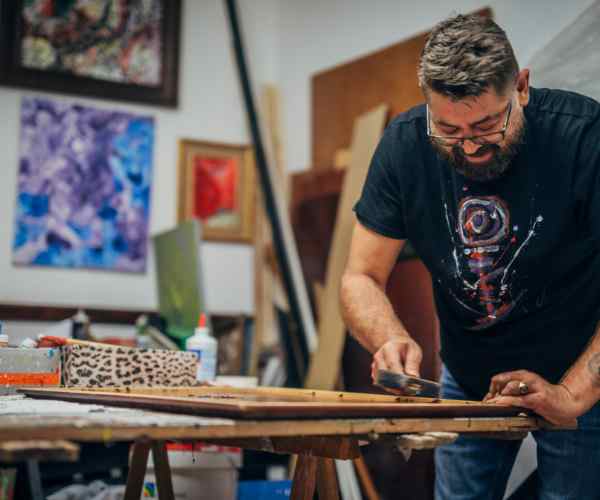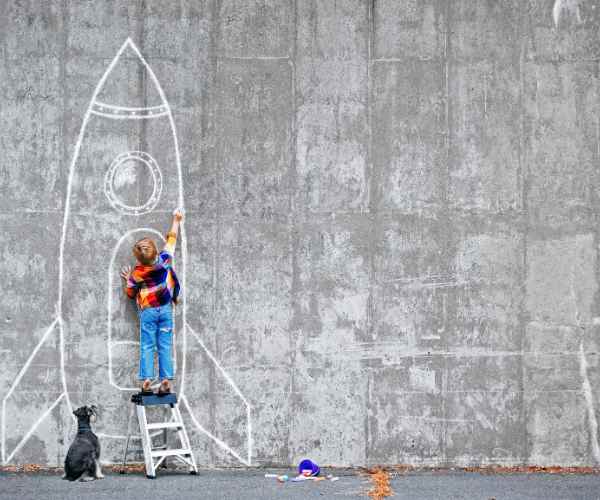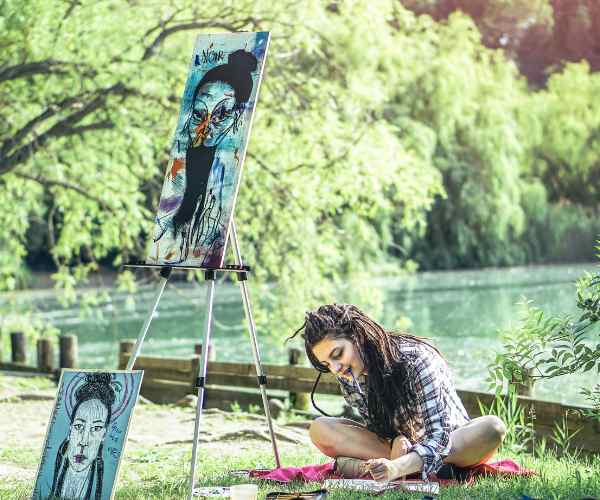Extracting creativity and artistic expression through exploring cultural practices works in today’s world as it helps enrich the expression and feels authentic.
I vividly remember visiting an art fair and being drawn towards an exhilarating collection of tribal masks from Africa. The stories behind the vibrant colors and complex designs made my heart race. It helped me connect with a culture that I have never visited, yet somehow gave insight into my own journey to become an artist. It changed the way I perceived art, and helped me understand the notion that art is a depiction of society, showcasing works from various cultures and all of their histories.
Art goes beyond just a canvas or sculpture with colors; it’s how we express ourselves and share emotions with the world. Every painting, carving, sculpting and every work of art retrieved its intricacies and history from the people who made it, the culture and traditions of that time.
Let’s take a plunge into this enthralling cultural infusion and how it can encourage artistic creations. With research and understanding we can extend the boundaries of are creativity and have a better understanding and respect for art.
How Culture Affect’s Art
Artisd have used traditions of culture to develop varied art styles on the basis of the message and meaning they intend to deliver in the art
Let us take African tribal masks as an example; it serves as more than just an artistic achievement on the bearer or artist’s forehead; it carries with it a wealth a cultural heritage, a community, and an ethos of spirituality. These masks serve a more primal role than just decoration: they perform central functions in rituals, which include ancestor worship, protection and even mediums for soul conversion. All of these are indicative of what resources are available in a given region, what tools the local craftsmen possess, and what knowledge has been preserved in the community.
Elaborately put paint and two brush strokes tell a tale, Japanese ink painting understood or subconsciously understood by the creator of the piece is taken directly from the philosophies of Zen, and teaches not only the master but the viewers the importance of minimalism and nature. A Japanese tea house comes to mind, where an ink painter has started his work, such the way he twirled the brush in the air to smoothly paint a singular strand of bamboo felt magical and alluring. It served as a reminder that the artistic expression beautifully merges with meditation in seeking unity with oneself and with the world around us.
Every society and culture has its own mode of artistic expression, which goes beyond of just purely aesthetics. These artifacts are history in some or another way, these art forms are mixtures of thoughts and tools communication. Chinese art too has color codes, red, for example, is used to represent beginning fortunes, black denotes stability and so on. And as artists, these rich traditions serve as a canvas to swipe inspiration from, and to add my meaning in components or construct components with deeper meanings.
Case Study: The Influence of Indigenous Art
Art work of the Indigenous peoples is informative of what a community believes in and their history. When we look at the work of Native American artists, we see a blend of history, spirituality, and sense of place. Each object, be it a jar, a woven piece or a painting, is embedded with the great stories of ancestors.
Let us consider the beadworks of Sioux tribes. Each bead must carry a message of culture or the environment as opposed to just beautifying. As I explored this art, I was increasingly intrigued how modern artists incorporate these designs in their current artworks. It is wonderful to respect history and at the same time be able to create through it.
Fedderson’s works are an impressive blend of Native American culture and the present-day worldview, while White Hawk’s works beautifully transform traditional paintings into vivid stories crafted using beadwork. Joe Fedderson and Dyani, are two such artists who have been making a difference in this realm. With the help of these artists, we realize that history is not something that is set in stone, rather it is subject to modifications, thus resulting in giving birth to new artists.
Rethinking of Cultural Structure in Works Of Art Today,
To emphasize the importance of current issues, modern artists are increasingly seeking inspiration from cultural legacies.
I think it is quite impressive how these artists incorporate some traditional aspects into their pieces. For example, Kehinde Wiley is known for creating classical portraits that are indeed great to look at. He integrates African American individuals in the approach of Old Master paintings along with some culturally important backdrops. When I first discovered his artwork, I was left in awe of how he preserved the identity of people by occupying that space in the history where they were almost always ignored. It isn’t merely artwork instead a strong statement about history and representation of people.
Yinka Shonibare, a UK Nigerian Artist, tends to merge Victorian dresses with African fabrics and from that he creates installations. His pieces normally consist of headless bodies that are dressed with Dutch wax print which are merged with colonial history and cultural influences. The last time I went to his exhibit, I could not help being stunned by the manner in which he deals with difficulties regarding identity and cultural lineage. With his work, we are forced to think about how older stories affect our reality and what we experience now.
In Shonibare and Wiley’s artworks, we witness a strong interaction between yesterday and today. Culture is not only about practice; it is about innovation and they advocate for change through their art. It’s like arbitrating – reaching out to people on an emotional and rational sphere of both heritage and present on the context.
Cultural Appropriation vs Appreciation
As we follow these creative avenues, it is important to point out the distinction between appropriation and appreciation. This concern is relevant in the arena of art world for a number of different reasons, however it should not be neglected within the creative spectrum.
Cultural appropriation is a form of expression that occurs when a culture is taken out of context with complete disregard of its meaning as well as modicum of respect and deference to the borrow is made, thus rendering it commercially exploitable. I have observed an array of artistic representations where the concept of cultural appropriation is utilized in a flippant manner, in which artistic works that incorporate conventional designs serve as mere decoration and lose their symbolism. This lack of context and sensibility is likely to assist in the stereotyping of the very cultures which are being alluded to.
Conversely, there are creators who pay respect to cultures while incorporating them into their work. Consider for example, the art of Frida Kahlo, which is very important in understanding cultural appreciation. She recreated Mexican folk art and included the indigenous elements of herself into her works with the intention of retelling her life in a different way. The artist believes that one can appreciate other cultures without distorting their meaning.
Everything is context and purpose-driven. Many artists amalgamating different inspirations are able to produce some meaningfully deep and insightful pieces. These debates are essential for both artists and the audience, especially now when it is very easy to engage in cultural exchange, as they allow to find answers to important questions.
Ways to Infuse Cultural Legacies Into Your Artwork
In case you are an artist who wants to create an actual piece of art out from cultural legacies, here are some effective methods to give it a go.
To start, learn to accept experiments. Take the plunge and work with new styles, materials, and techniques of other cultures. For example, you may wish to consider Indian Rangoli colors or Islamic tile work patterns as a challenge. Mixing these elements can yield fascinating results in your own practice.
Another significant way to broaden your horizons is to attend cultural exhibitions. I personally enjoy visiting local art shows and festivals, which is a great way of experiencing various cultures. These events help you to view the works of such art in real life, understand their historical context, and meet the artists behind them. Interacting with local communities may also greatly enrich your understanding of the cultural role that some techniques or motifs have.
Finally, develop networks. Meeting with professionals from other cultures may be a good way to extend avenues for creativity and collaboration. You might want to contact local cultural institutions, or artists’ co-operatives. Their stories and experiences could deepen your perspective and substantially motivate you in your work.
Getting started with cultural traditions and incorporating them into your art can be a fruitful process that can not only boost your imagination but help you understand the multifaceted nature of human life better.
Art as a Cultural Story
Art, indeed, rest on storytelling, for it serves as a link between the artist and the viewer.
Stirring emotions as well as gorgeous visuals is what a story does. When such stories depict an artist’s journey, their thoughts and feelings, and works of a street artist portraying their community, such designs make an artwork stunning and almost irreplaceable. This gripping aspect of art is complemented with cultural aspects to make a phenomenal piece. As we create art, we are able to capture our journey through the artworks on the canvas. Such was the case with a friend who is also, a textile artist. In one of the discussions we had, she talked about her grandmother who introduced her to weaving and other traditional practices to support ethnic pride. The amalgamation of culture and family in her engineering works is just breathtaking. For every piece of art tears along a thread, and the thread is a memory to the viewers.
As I said previously, the idea is to pretty much allow artists to delve into a personal storytelling format of their work. Imagine how special something would be if it is done by combining personal experiences and cultural influences, such a piece would be simply out of this world. The chances are that the audience will be able to sense that and engage with your artwork on a much deeper level, rather than just the surface level of seeing it. It is not only a painting or a sculpture that they are gazing into, they become a part of a story, a culture, and a reality.
A unique aspect of art is its ability to foster empathy through storytelling. It puts things in a way where an audience can put themselves in the person’s shoes, making art a wonderful tool for cross cultural communication. The stories we construct can be used to expand, challenge or defend a point in time. In the international space where we exist today, where understanding each culture is difficult than ever, a story laden piece of artwork can break barriers and bring people together.
FAQs
How can one draw inspiration from cultural practices?
It can be a rather enriching and wholesome process of exploring oneself.
Museums are a great place to start. Most museums have specialized exhibitions that focus on certain artistic forms within specific cultures and history, and they include art in different societies. I enjoy taking slow walks in the hall of a museum and soaking in the color, texture and history of the displayed pieces. All of the exhibits have a story and I find it a good time to write some notes that pop in my mind.
Books are equally good. Whether it is art history books or novels featuring different societies, if you read literature, it will definitely get your creative juices flowing. I once read several folk tales from a variety of cultures and I have learnt a great deal about the meanings of symbols people used to represent different ideas.,
Also, bear in mind that cultural activities have their own significance. Art can also be vividly demonstrated during festivals, workshops and community events. For example, I remember attending a local culture festival where craftsmen, who were honing their skills, made things and gave presentations on them. It was very exciting to see how different societies used personal history as a medium of the art they make.
How can I integrate culture into my art without being disrespectful?
There is a need for caution when it comes to the incorporation of culture into art that needs to be done by people.
You can begin your journey by learning more about the elements you want to incorporate in your artwork and the significance it bears to the culture. Look into the origins and history of symbols or patterns and ensure you use them in accordance with what their meaning is. I specifically recall wanting to use a certain pattern found in the art of Indigenous people for my project and so I researched about its context and history. That kind of research not only enhanced the respect I developed for that art form, but also directed how I intended to use it.
It’s equally important to participate in the culture’s community. Participate in active discussions with local artists and ask questions by enrolling in workshops. Most of the times, when people see that you are genuinely interested in their culture, they appreciate it and are more than willing to share their knowledge and experiences with you. That conversation in particular forms your understanding of cultural practices and adds value to the work you’re doing.
Can I use different cultural elements together in my artwork?
Yes, using them together will enhance your work by providing new artistic insights.
That being said, unity of different cultures in your artwork is not a concept that should be taken lightly. If approached correctly, then laying cultures on top of one another can produce an entirely new story, and can foster multicultural interactions within and across regions. For example, I’ve seen artists successfully combine elements from various cultures, creating one work while honoring the traditions of all people with respect to a common experience.
The secret is not to compromise, ensuring your ‘mixing styles’ is not done simply for the sake of aesthetics, whilst considering that the cultural aspects have the right to reside within your body of work. Your work can also be interpreted as an embrace of different inspirations, thus highlighting the beauty of interconnectedness of all the people of the planet.
Conclusion
The inspiration that we derive from the cultural practices provides depth to the artistic work and places the work in a context that is larger than self.
Art has this strong ability to break borders, to use a language that everyone on earth can understand. So, am I incorporating certain styles from other cultures into my work and not just the physical imagery? Indeed, this stylistic practice of cultural appropriation is but a pejorative term when it should capture and honor the narratives, morals and furthermore the cultures that are attached to those traditions.
Consider it: any design you create using a tradition of culture is the context in which multiple voices, geographies, and time periods coexist. You are creating a beautiful blend of the past and the present, allowing the past to be alive, to be amazing, for more people to hear.
As an artist, one of the most fulfilling experiences can be discovering cultural practices, enjoying growing both as an artist and a person. Asong, there is an encouragement to push work boundaries, shift perspectives, widen the approaches taken — so if you’re tracing the stories of your ancestors or learning to operate a Japanese brush, never forget that your art was made to serve those outside of you.
In the process of developing your creativity or skills, I would recommend looking for activities that are rooted in a culture, being an active member of the societies, and indulging in stories that move you. Allow those experiences and societies to inspire you to produce work that is not only aimed toward your vision but also universal in nature.
Art, fundamentally, is about people, and that includes yourself and places around you: your culture, other cultures and other people. Accept those bonds and use them while constructing your way of being an artist.






